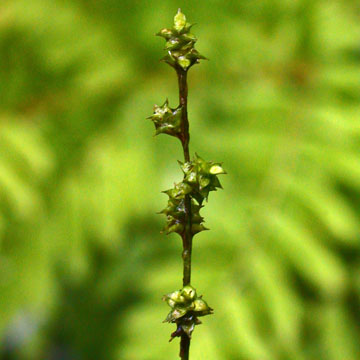

Carex seorsa - (image 1 of 4)
Taxonomy
Family: Cyperaceae
Section Stellulatae
Habitat
Bogs, swamps, wet woods.
Associates
Distribution
Southern NH to GA along the coastal plain and occasion inland to northern OH, southern Ontario, MI, northwest IN and TN.
Morphology
Tufted perennial to 70 cm; aphyllopodic; stems smooth; leaves 2-4 per stem, restricted to basal third, often shorter than the stems, flat or plicate, 1-4 mm wide; spikes 4-8, sesssile, few-flowered, at least the terminal spike gynaecandrous; perigynia 5-25, crowded, spreading to reflexed below, green, planoconvex, thickened and spongy at the base, elliptic-ovate, 2-3 mm long by 1-2 mm wide, 1.2-2.1 times as long as wide, smooth-margined; beak of perigynium smooth, truncate or obscurely bidentate, 0.2-0.6 mm, to a third as long as the body; achene lenticular; stigmas 2.
Notes
Fruiting late April to June.
Wetland indicator: OBL
This specimen was found growing in an open sphagnum bog. The smooth margin of the beak of the perigynium separates this species from several other sedges in this section. Another useful characteristic is that the perigynia are typically green at maturity and the culm often falls over before they have been shed.
References
Gleason, Henry A. and A. Cronquist. 1991. Manual of Vascular Plants of
Northeastern United States and Adjacent Canada. Second Ed.
The New York Botanical Garden. Bronx, NY
Swink, F. and G. Wilhelm. 1994. Plants of the Chicago Region.
Indiana Academy of Science. The Morton Arboretum. Lisle, Illinois.
|
© Michael Hough 2010 |